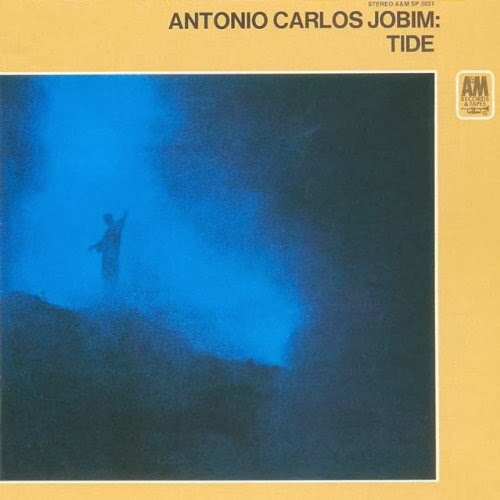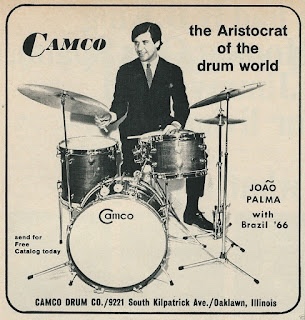
Remember is a track that’s always spoken to my heart’n’soul, if you know what I mean? I’m not entirely sure why. I guess I might think ‘bout that over the course of this post.
It’s the fifth track on Tide, Jobim’s sixth solo album, recorded at Rudy Van Gelder’s legendary studio, and released on A&M in 1970.
Tide itself is interesting, to me at least, for numerous reasons. For example, it has only one of his most famous tracks, opening with The Girl From Ipanema. The remainder are all lesser known.
Right from the first time I heard this album, Remember was my favourite track. There are, I think, several reasons why. First of all it grooves hard, in my opinion. It even has a certain funkiness to it. Not in an obviously JB type way, perhaps. But, well…
The rhythm section – and this track is basically just rhythm section, with only a very light smattering of melody – is brilliant. Jobim is on various keys, including, quite unusually, electric (sounding like a Rhodes or Wurli’?). We’ll come back to his keys playing in a mo’, as it’s, ummm… key to the feel of the track.
Then there’s Ron Carter on bass, Joao Palma on drums, and Everaldo Ferreira on congas. Airto Moreira is credited on percussion for the album as a whole, but I don’t hear him on this number. Carter is an absolute jazz giant, of course. Most famous for his stint in the Hancock/Shorter/Williams Miles quintet. And Moreira successfully crossed over Stateside, getting into the jazz and studio scenes.

João Palma was a legend in Brazil, and was still playing until he passed away, quite recently. Ferreira might still be playing (I found him – or at least a conguero of the same name – playing some street music on YouTube!). But they’re less known to music lovers outside Brazil, except perhaps the odd devotee.
As a unit they drive the pretty brisk and quite harmonically dense music along with a deft lightness of touch that is simultaneously energetic and laid back. A staple of the ‘samba jazz’ feel, but quite a feat, as you would know if you’ve tried it.
Now we come to Jobim’s playing. It’s totally in the Goldilocks zone. For me at least. Neither too much, nor too little. Just the absolutely perfect balance. And the various sections fall into a few different categories.
What I mean by that is that, after a ten bar intro, with an inverted pedal – a frequent Jobim ploy, the melody atop the chords staying on just one or two notes, as the chords shift underneath – we get very similar 12 bar cycles, all progressing with very similar harmonic/melodic logic, and yet all subtly different.
As a drummer, primarily, and almost entirely self-taught, with little to no academic grounding in music theory whatsoever, I’m probably going to embarrass myself now, by not knowing the correct terminology. But maybe someone in the know will read this and enlighten me?
So, as noted, we start with a 10 bar intro, the top note hanging on a B throughout, as the chords move about underneath. This type of section recurs throughout the piece, including immediately after the first iteration, but in a longer 12 bar form, and with a differing (but from this point on very similar) set of chords anchoring it. Sometimes the top note is the same B as the intro, at other times it’s a lower F.

These sections are predominantly chordal, and very, very rhythmic. The chord voicings are quite ‘dense’. Easier to achieve on a keyboard than on a guitar (Jobim played both beautifully, oh, and flute!). But on this number it’s all keys and no guitar. Part of my fascination for Remember lies in my desire to do it on guitar! Very minimal and subtle use is made of notes occasionally moving slightly out of sync with the main ‘blocked’ chords.
Then there are the melody sections. Apart from the intro and bridge or middle-eight these follow the very similar sets of chords that form most of the piece. Again, these are 12 bars long. But then there’s the quite chirpy middle-eight (or 16, if we’re being exact), an eight bar section that’s repeated with slightly differing first and second time endings. These are the most song-like parts of this piece.
Unlike many of Jobim’s best known tunes, like Ipanema, Desafinado, One Note Samba, etc, but actually quite typical within his greater body of work, almost every iteration of any given section is very deliberately and very specifically voiced, all slightly differently, albeit very closely linked and always resolving to the same final G6 chord.
I do want to learn to play this number on keys at some point. But my first port of call is the guitar. It’s what I know best, after drums. Plus I think a guitar version could be a nice and different take on what is very much a keyboard piece.
I got the score from an absolutely superb Tom centred website, which has most of not all of his music really well written out for piano. Turning the piano chords into guitar versions that keep the feel of the original is, at least for me, a real challenge. Working from the chord names I start by using an online tool like jguitar.com’s chord finder/creator.
I also frequently use ASD, Amazing Slow Downer, a great software tool, to help me clarify what I’m hearing. With this pretty pacey tune, it was absolutely essential! Certain segments came together relatively quickly and easily, such as the 10-bar intro and the 12-bar sequence that immediately follows it. But others were – and indeed still are – a real mother!
The melody lead parts were the easiest, as working from the beautifully accurate piano chords quickly lead me to appropriate guitar chords. As and when I come to record a version of Remember, I will be incorporating the melody, most likely as a separate voice. But for the ‘fixed note’ sections – or inverted pedal parts (the notes are atop the chords!) – the fairly stationary ‘melody’ is integral to the chords.
As already noted, some of these came together very quickly, others, in particular iteration #(?), or bars ??-??, were extremely challenging. This comes out of the fact that densely voiced chords, easy on keys, can be near impossible on guitar, depending on exactly which notes are concerned.
The fact that the topography of the guitar neck forces one to relocate certain notes to differently pitched positions really alters the sound and feel, and even the ‘width’ or ‘depth’, of the chords. Tricky!
Anyway, I’ve created a chord sheet – actually still a work in progress – for Remember. And the bulk of it is, I’m happy to say, quite satisfactory to me. There is one troublesome segment, already alluded to above. And I’m still working hard to complete that in a satisfactory manner.
And then there’s actually playing it on guitar competently. That also is very much a work in progress! The original is a brisk 183bpm, or thereabouts. If I do get around to doing a guitar based recording – and I very much hope I will – I might opt to take the pace down a little, perhaps even as far as 170-5? We shall see!
One issue is that pesky progression that’s harder than the others – oh, and the middle 8/16 – as both have one or two chord progressions that require left-hand ninja skills I’m going to need to acquire!
My goal is a version on which I play all instruments, poss even a flute doing the melody. Certainly drums, congas, bass, guitar, poss a little keys. But as my flute skills haven’t got a far as making a reliable clean note, I will prob have to either sing the melody, or get someone in to do that icing on the cake bit!
